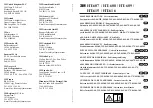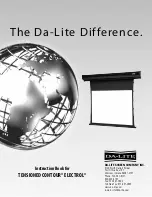
Vertiv
™
| Liebert® XDC | User Manual
52
6.7. Terminal Fan
Regular inspections include the running status of the motor, the status of the fan impeller, the fixing of fan components, and
the clearance between the fan and the air guide ring, etc.
Pay special attention to whether the fan assembly and the air guide ring are firmly installed, and whether there is the
possibility of touching the nearby sheet metal parts when the blades rotate. At the same time, any abnormal airflow channel
blocking factors should be eliminated in time to avoid the any damage to the cooling system and other system components
from the reduction of airflow volume.
The terminal fan needs to input the main power of 48 Vac, and at the same time rely on the 0 V to 10 V DC analog signal
output by the control board to adjust the speed. When the fan is abnormal or does not rotate, check the analog signal, main
power supply, and filter net blockage.
The steps to replace the fan are as follows:
1. Cut off the power supply of the whole unit.
2. Remove the screws fixing the fan mounting plate, and remove the fan.
3. Reinstall the replaced fan. During the installation process, pay attention to the terminal corresponding relationship and
check if the contacts are firmly connected.
Note: Do not maintain the fan during the operation of the fan to avoid injury.
Note: During the operation of the unit, it is forbidden to touch the fan net cover to prevent mechanical damage caused by
the operation of the fan.
6.8. Air-cooled Condenser
Refer to the related information in Maintenance in “Vertiv
™
Liebert® LVC Condenser User Manual”.
6.9. Compressor
The Vertiv
™
Liebert® XDC units use variable capacity compressors, which are highly reliable and require engineering
construction to strictly follow correct procedures.
•
The compressor motor is rarely burned out due to insulation failure. In the event that the motor is indeed
burned out, most are caused by poor mechanical or lubrication, that is, high temperature and overheating.
• If the problems that may cause compressor failure can be detected and corrected early, most compressor failures can
be avoided. The maintenance personnel should regularly conduct maintenance and inspection of abnormal operation
conditions that may occur. Instead of replacing the compressor after a failure, it is better to take the necessary steps to
ensure the normal operation of the system. This is not only easier but also much cheaper.
When troubleshooting the compressor, check whether all electrical components of the compressor are operating normally:
1. Check all fuses and circuit breakers.
2. Check the operation of the high voltage switch and low pressure sensor.
3. If the compressor malfunctions, find out whether the compressor malfunction is caused by an electrical failure or a
mechanical failure.
When replacing the compressor, avoid skin contact or contact with refrigerant and lubricating oil. If
contact with refrigerant or lubricating oil, it can cause severe burns or frostbite to the skin. Wear
long-sleeved gloves when handling contaminated parts.












































